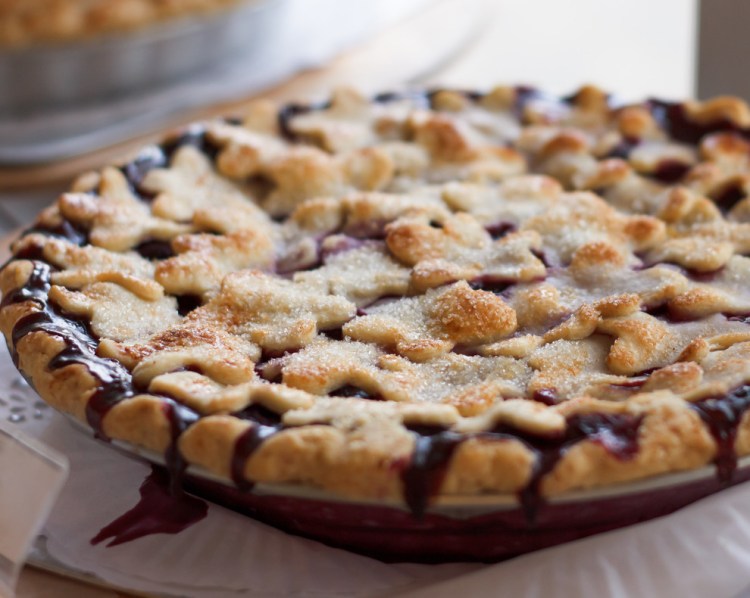Here it is blueberry season again, and blueberries always make me think of pie – my favorite way to eat them even though it means making pastry and firing up the oven in the heat of summer. Nothing says “America” quite like pie (or “Maine!” quite like blueberry pie). How did pie become so iconic? And what about this business of pie for breakfast?
“The pie is an English institution, which, planted on American soil, forthwith ran rampant and burst forth into an untold variety of genera and species,” wrote Harriet Beecher Stowe in her 1869 novel “Oldtown Folks.” “Not merely the old mince pie, but a thousand strictly American seedlings from that main stock, evinced the power of American housewives to adapt old institutions to new uses.”
Stowe’s observation, which was part of a larger portrait of New England life in the years following the Revolutionary War, seemed to express not only the transformation of English pie, but also the transformation of the English settlers themselves into Americans: as American as apple pie.
Baking skills – and apples, which weren’t native to America – arrived in New England along with the first groups of colonists. They came largely from the east of England, a region defined by its baking traditions as strongly as, say, frying (as in fried chicken) defines the American South.
They also brought wheat, which made the most delicate pastry crust. Farmers soon discovered that wheat didn’t grow well in New England, making it a precious commodity until the more wheat-friendly regions to the west and south began to produce and trade in grain and flour. “Imported” wheat flour from New York, Pennsylvania and Virginia supplemented local inventories by the early 1800s.
Pie made the most of limited wheat supplies and expensive sugar by stretching it with less expensive lard or butter and summer’s sweet, ripe fruit. Some berries, stone fruits and early apples would be preserved for winter use, some would be eaten fresh, and some baked into pies – all practices that have continued through the centuries.
“Baked blueberry pies & putting some in cans and bottles,” wrote Louisa Talbot of South Freeport, Maine, in her July 27 diary entry in 1867. Similar entries appear today in some Mainers’ version of the diary: the blog.
Summer pies had to be consumed soon after baking, but as frost fell and Thanksgiving approached, pies were baked by the score and stored in freezing-cold pantries for use through the winter. In her memoir, “A Doctor in Homespun,” Mary Dole of Massachusetts recalled the mammoth pie-baking of Thanksgiving time in the 1870s. Her family baked dozens of mince, pumpkin and apple pies. “They were put in the upstairs pantry where they would freeze and keep several weeks. Often we had pie three times a day, always for breakfast. In winter it would be mince.” In August, I’d bet that breakfast pie would have been blueberry.
Pie became so strongly identified with America by the 19th century that writers and journalists from both near and far declared Americans to be suffering a kind of pie madness. New Englanders, who were particularly prone to pie-eating, made good fodder for satire and good targets for scolding by increasingly health-conscious cookbook writers. As more Americans traveled abroad and became acquainted with European food culture, it became fashionable to condemn pie as food for the “rustic.”
George Augustus Sala, a verbose British journalist, used “an unholy appetite for Pie” to satirize Americans on both sides of the Mason-Dixon line in the Civil War period. “The real social curse of the Atlantic States is Pie,” he wrote in his 1860s diaries. “There the Pie fiend reigns supreme… In the State of Massachusetts, for instance, you have pork and beans every Sunday, but you have Pie morning, noon, and night every day, all the year round.” In Sala’s estimation, pie was to blame for “the sallow faces, the shrunken forms, the sunken eyes, the morose looks, the tetchy temperament of the Northerners.”
Charles Dudley Warner, who was a writer friend of Mark Twain’s, in the mid-19th century imagined a “region of perpetual pie” that existed roughly north of a line drawn from Portsmouth, New Hampshire, westward to Bellows Falls, Vermont, and especially in the higher elevations. “I find that all the hill and country towns of New England are full of those excellent women, the very salt of the housekeeping earth, who would feel ready to sink in mortification through their scoured kitchen floors, if visitors should catch them without a pie in the house.”
Nutrition-minded cookbook author Marion Harland opined in “Breakfast, Luncheon and Tea,” published in 1875, that breakfast should be “a pleasing medium between the heavy cold beef and game pie of the English and the… too light morning refreshment of the French.” America’s rapid industrialization was affecting our meal patterns – as more and more work became urban and sedentary, we no longer needed a big breakfast to stoke us for the day’s work. But, in Harland’s view, we needed more than a fashionably French-style breakfast consisting simply of coffee and perhaps a roll or croissant.
Ralph Waldo Emerson found pie to be just such a pleasing medium, as his friend James Thayer recalled, describing a breakfast taken with Emerson and friends in the 1870s. Pie, Thayer reported, “at breakfast was one of Mr. Emerson’s weaknesses.” Emerson offered slices to his fellow diners, who one by one declined, prompting him to protest in humor, “but … what is pie for?”
Breakfast, evidently.
Send questions/comments to the editors.



Comments are no longer available on this story